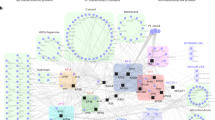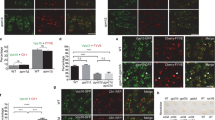Abstract
Myristoylation of ARF family GTPases is required for their association with Golgi and endosomal membranes, where they regulate protein sorting and the lipid composition of these organelles. The Golgi-localized ARF-like GTPase Arl3p/ARP lacks a myristoylation signal, indicating that its targeting mechanism is distinct from myristoylated ARFs. We demonstrate that acetylation of the N-terminal methionine of Arl3p requires the NatC Nα-acetyltransferase and that this modification is required for its Golgi localization. Chemical crosslinking and fluorescence microscopy experiments demonstrate that localization of Arl3p also requires Sys1p, a Golgi-localized integral membrane protein, which may serve as a receptor for acetylated Arl3p.
This is a preview of subscription content, access via your institution
Access options
Subscribe to this journal
Receive 12 print issues and online access
$209.00 per year
only $17.42 per issue
Buy this article
- Purchase on Springer Link
- Instant access to full article PDF
Prices may be subject to local taxes which are calculated during checkout




Similar content being viewed by others
Change history
30 April 2004
Amy Hin Yang to Amy Hin Yan
References
Antonny, B., Beraud-Dufour, S., Chardin, P. & Chabre, M. N-terminal hydrophobic residues of the G-protein ADP-ribosylation factor-1 insert into membrane phospholipids upon GDP to GTP exchange. Biochemistry 36, 4675–4684 (1997).
Goldberg, J. Structural basis for activation of ARF GTPase: mechanisms of guanine nucleotide exchange and GTP-myristoyl switching. Cell 95, 237–248 (1998).
Renault, L., Guibert, B. & Cherfils, J. Structural snapshots of the mechanism and inhibition of a guanine nucleotide exchange factor. Nature 426, 525–530 (2003).
Nie, Z., Hirsch, D.S. & Randazzo, P.A. Arf and its many interactors. Curr. Opin. Cell Biol. 15, 396–404 (2003).
Dascher, C. & Balch, W.E. Dominant inhibitory mutants of ARF1 inhibit ER to Golgi transport and trigger the disassembly of the Golgi apparatus. J. Biol. Chem. 269, 1437–1448 (1994).
Kahn, R.A. et al. Mutational analysis of Saccharomyces cerevisiae ARF1. J. Biol. Chem. 270, 143–150 (1995).
Gommel, D.U. et al. Recruitment to Golgi membranes of ADP-ribosylation factor 1 is mediated by the cytoplasmic domain of p23. EMBO J. 20, 6751–6760 (2001).
Gangi Setty, S.R., Shin, M.E., Yoshino, A., Marks, M.S. & Burd, C.G. Golgi Recruitment of GRIP Domain Proteins by Arf-like GTPase 1 Is Regulated by Arf-like GTPase 3. Curr. Biol. 13, 401–404 (2003).
Panic, B., Whyte, J.R. & Munro, S. The ARF-like GTPases Arl1p and Arl3p Act in a pathway that interacts with vesicle-tethering factors at the Golgi apparatus. Curr. Biol. 13, 405–410 (2003).
Barr, F.A. A novel Rab6-interacting domain defines a family of Golgi-targeted coiled-coil proteins. Curr. Biol. 9, 381–384 (1999).
Munro, S. & Nichols, B.J. The GRIP domain — a novel Golgi-targeting domain found in several coiled-coil proteins. Curr. Biol. 9, 377–380 (1999).
Kjer-Nielsen, L., Teasdale, R.D., van Vliet, C. & Gleeson, P.A. A novel Golgi-localisation domain shared by a class of coiled-coil peripheral membrane proteins. Curr. Biol. 9, 385–388 (1999).
Panic, B., Perisic, O., Veprintsev, D.B., Williams, R.L. & Munro, S. Structural basis for Arl1-dependent targeting of homodimeric GRIP domains to the Golgi apparatus. Mol. Cell 12, 863–874 (2003).
Lu, L. & Hong, W. Interaction of Arl1-GTP with GRIP domains recruits autoantigens Golgin-97 and Golgin-245/p230 onto the Golgi. Mol. Biol. Cell 14, 3767–3781 (2003).
Tong, A.H. et al. Systematic genetic analysis with ordered arrays of yeast deletion mutants. Science 294, 2364–2368 (2001).
Tong, A.H. et al. Global mapping of the yeast genetic interaction network. Science 303, 808–813 (2004).
Tsukada, M. & Gallwitz, D. Isolation and characterization of SYS genes from yeast, multicopy suppressors of the functional loss of the transport GTPase Ypt6p. J. Cell Sci. 109, 2471–2481 (1996).
Votsmeier, C. & Gallwitz, D. An acidic sequence of a putative yeast Golgi membrane protein binds COPII and facilitates ER export. EMBO J. 20, 6742–6750 (2001).
Polevoda, B. & Sherman, F. NatC Nα-terminal acetyltransferase of yeast contains three subunits, Mak3p, Mak10p, and Mak31p. J. Biol. Chem. 276, 20154–20159 (2001).
Bensen, E.S., Yeung, B.G. & Payne, G.S. Ric1p and the Ypt6p GTPase function in a common pathway required for localization of trans-Golgi network membrane proteins. Mol. Biol. Cell. 12, 13–26 (2001).
Polevoda, B. & Sherman, F. N-terminal acetyltransferases and sequence requirements for N-terminal acetylation of eukaryotic proteins. J. Mol. Biol. 325, 595–622 (2003).
Kimura, Y. et al. N-terminal modifications of the 19S regulatory particle subunits of the yeast proteasome. Arch. Biochem. Biophys. 409, 341–348 (2003).
Huh, W.K. et al. Global analysis of protein localization in budding yeast. Nature 425, 686–691 (2003).
Singer, J.M. & Shaw, J.M. Mdm20 protein functions with Nat3 protein to acetylate Tpm1 protein and regulate tropomyosin-actin interactions in budding yeast. Proc. Natl Acad. Sci. USA 100, 7644–7649 (2003).
Williams, B.C. et al. Two putative acetyltransferases, san and deco, are required for establishing sister chromatid cohesion in Drosophila. Curr. Biol. 13, 2025–2036 (2003).
Pesaresi, P. et al. Cytoplasmic N-terminal protein acetylation is required for efficient photosynthesis in Arabidopsis. Plant Cell 15, 1817–1832 (2003).
Petracek, M.E. & Longtine, M.S. PCR-based engineering of yeast genome. Methods Enzymol. 350, 445–469 (2002).
Longtine, M.S. et al. Additional modules for versatile and economical PCR-based gene deletion and modification in Saccharomyces cerevisiae. Yeast 14, 953–961 (1998).
Seron, K. et al. A yeast t-SNARE involved in endocytosis. Mol. Biol. Cell 9, 2873–2889 (1998).
Shin, M.E., Ogburn, K.D., Varban, O.A., Gilbert, P.M. & Burd, C.G. FYVE domain targets Pib1p ubiquitin ligase to endosome and vacuolar membranes. J. Biol. Chem. 276, 41388–41393 (2001).
Altschul, S.F. & Koonin, E.V. Iterated profile searches with PSI-BLAST–a tool for discovery in protein databases. Trends Biochem. Sci. 23, 444–447 (1998).
Thompson, J.D., Higgins, D.G. & Gibson, T.J. CLUSTAL W: improving the sensitivity of progressive multiple sequence alignment through sequence weighting, position-specific gap penalties and weight matrix choice. Nucleic Acids Res. 22, 4673–4680 (1994).
Acknowledgements
We thank M. Marks, M. Chou, M. Lemmon, T. Graham, S. Emr and E. Bi for discussions, M. Chou for reading the manuscript, E. Bi and F. Luca for the use of their fluorescence microscopes, G. Van Duyne and J. Fields for the use of their cell lysis apparatus, and S. Munro for sharing unpublished information. We are indebted to C.-X. Yuan and the staff of the Proteomics Core Facility of the Genomics Institute and the Abramson Cancer Center, University of Pennsylvania, for assistance with the Arl3p mass spectrometry. This research was supported by a grant (GM61221) from the National Institutes of Health to C.G.B.
Author information
Authors and Affiliations
Corresponding author
Ethics declarations
Competing interests
The authors declare no competing financial interests.
Supplementary information
Supplementary Figures
Supplementary Information, Fig. S1 (PDF 3778 kb)
Supplementary Information, Fig. S2
Supplementary Information, Fig. S3
Supplementary Information, Fig. S4
Supplementary Information, Fig. S5
Rights and permissions
About this article
Cite this article
Setty, S., Strochlic, T., Tong, A. et al. Golgi targeting of ARF-like GTPase Arl3p requires its Nα-acetylation and the integral membrane protein Sys1p. Nat Cell Biol 6, 414–419 (2004). https://doi.org/10.1038/ncb1121
Received:
Accepted:
Published:
Issue Date:
DOI: https://doi.org/10.1038/ncb1121
This article is cited by
-
N-terminal acetylation shields proteins from degradation and promotes age-dependent motility and longevity
Nature Communications (2023)
-
NAA60 (HAT4): the newly discovered bi-functional Golgi member of the acetyltransferase family
Clinical Epigenetics (2022)
-
In Vitro N-Terminal Acetylation of Bacterially Expressed Parvalbumins by N-Terminal Acetyltransferases from Escherichia coli
Applied Biochemistry and Biotechnology (2021)
-
Divergent architecture of the heterotrimeric NatC complex explains N-terminal acetylation of cognate substrates
Nature Communications (2020)
-
A yeast phenomic model for the influence of Warburg metabolism on genetic buffering of doxorubicin
Cancer & Metabolism (2019)



